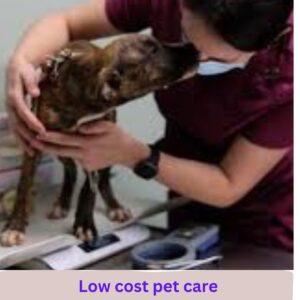Low cost pet care will explore practical tips and tricks for taking while ensuring 100% that they remain healthy and well-cared for.

Pets bring so much joy and companionship into our lives, but taking care of them can often come with a hefty price tag. From veterinary bills to high-quality pet food, the Low cost pet care can quickly add up. However, there are ways to keep our pets healthy and happy . By making smart choices and being proactive in our pet care routines, we can provide our beloved animals with the care they need while still staying within a budget.
From homemade pet food recipes to budget-friendly veterinary care options, we will cover a variety of strategies that pet owners can implement to save money without sacrificing the well-being of their pets. By being resourceful and creative in our approach to pet care, we can create a happy and healthy environment for our pet companions while saving money in the process.
Taking care of pets on a budget while keeping them healthy requires some creativity and resourcefulness. Here are some tips:
- Regular Exercise to low cost pet care
- Nutritious Diet to low cost pet care
- Preventive Care for low cost pet care
- DIY Grooming to low cost pet care
- Routine Vet Check-ups to low cost pet care
- Pet Insurance to low cost pet care
- DIY Toys and Enrichment
- Train at Home to low cost pet care
- Community Resources to low cost pet care
- Tick Prevention to low cost pet care
Regular Exercise to low cost pet care
Engage your pets in regular exercise. This doesn’t have to involve expensive toys or equipment. Simple activities like playing fetch, going for walks, or creating DIY agility courses can keep them active and healthy. Regular exercise is essential for maintaining the overall health and wellbeing of your pets. Not only does it help to keep them physically fit, but it also provides mental stimulation and helps prevent behavioral issues such as excessive barking or destructive chewing.

One of the best ways to provide regular exercise for your pets at a Low cost pet care is to take them for daily walks. This simple activity not only provides physical activity, but also allows your pets to explore their surroundings and socialize with other animals and people. Make sure to vary the routes and environments of your walks to keep things interesting for your pets.
If you have a yard or outdoor space, let your pets roam and play freely. Setting up a homemade obstacle course using items like cardboard boxes, old tires, and PVC pipes can provide hours of entertainment and physical activity for your pets. You can also engage them in games like fetch or hide-and-seek to keep them active and mentally stimulated. Incorporating regular playtime into your pets’ daily routine is another great way to ensure they get enough exercise. Use toys like feather wands for cats or rope toys for dogs to engage them in interactive play sessions. You can also make DIY toys using household items like empty toilet paper rolls or crumpled-up paper bags.
Nutritious Diet to low cost pet care

When it comes to taking care of your pets on a budget, one of the most important things you can do is to provide them with a nutritious diet. It’s important to understand your pet’s dietary needs. Different animals have different nutritional requirements, so it’s essential to do your research or consult with a veterinarian to find out what your specific pet needs to thrive. For example, cats require a diet high in protein, while dogs need a mix of protein, carbohydrates, and fats.
Once you have a good understanding of what your pet needs, it’s time to start looking for cost-effective options. One way to save money on pet food is to buy in bulk. Purchasing larger bags of food can often be cheaper per pound than buying smaller bags. You can also look for store brands or generic versions of pet food, which are typically more affordable than name-brand options.
Another way to save money on pet food is to watch for sales and discounts. Many pet stores and online retailers offer promotions and coupons that can help you save on your pet’s favorite food. You can also consider joining loyalty programs offered by pet food manufacturers, which often come with discounts and rewards for frequent purchases.
Low cost pet care to traditional pet food, there are also other cost-effective options you can explore to provide your pet with a nutritious diet. For example, you can supplement your pet’s diet with fresh fruits and vegetables, cooked meats, or even homemade meals. Just be sure to research which foods are safe and healthy for your pet, as some human foods can be toxic to animals.
It’s important to keep an eye on your pet’s weight and overall health when feeding them a Low cost pet care diet. Obesity is a common issue among pets, which can lead to a variety of health problems. Make sure to monitor your pet’s food intake and adjust their diet as needed to ensure they’re staying at a healthy weight.
opt for high-quality, affordable pet food. Look for brands that offer good nutrition at a reasonable price. You can also supplement their diet with homemade meals using inexpensive ingredients like rice, vegetables, and lean meats. Consult your vet for guidance on a balanced diet.
Preventive Care for low cost pet care

Invest in preventive care to avoid costly vet bills down the line. Keep up with vaccinations, flea and tick prevention, and regular grooming to maintain your pet’s health and hygiene. Preventive care for pets is all about staying ahead of potential health issues before they become a big problem. This not only helps keep your pet healthy, but it can also save you money in the long run by avoiding costly vet bills. One of the most important aspects of preventive care is making sure your pet is up to date on their vaccinations.
Vaccines are essential for preventing diseases that can be harmful or even fatal to your pet. By keeping your pet vaccinated, you can protect them from illnesses like rabies, distemper, and parvovirus. Many local animal shelters or clinics offer low-cost vaccination clinics, so be sure to keep an eye out for those opportunities to save money while keeping your pet healthy.
Another important aspect of preventive care is regular check-ups with your veterinarian. During these check-ups, your vet can perform a physical exam to check for any potential health issues. This can help catch problems early on when they are easier and Low cost pet care to treat. It’s also a good idea to discuss your pet’s diet and exercise routine with your vet to make sure they are staying healthy and fit.
Maintaining good oral hygiene is also an important part of preventive care for pets. Dental problems can lead to a host of health issues, so it’s important to brush your pet’s teeth regularly and provide them with dental chews or toys to help keep their teeth clean. If your pet is at risk for dental problems, your vet may recommend a professional dental cleaning, but regular home care can help prevent the need for more invasive treatments.
Regular exercise is another key component of preventive care for pets. Exercise not only helps keep your pet at a healthy weight, but it also provides mental stimulation and helps prevent behavioral issues. Taking your pet on regular walks or playing with them in the backyard are great ways to keep them active and healthy without spending a lot of money.
DIY Grooming to low cost pet care
Learn to groom your pets at home. Basic grooming tasks like brushing their pet, trimming nails, and cleaning ears can be done with inexpensive grooming tools purchased once and used multiple times.

Grooming your pet is an essential part of keeping them healthy and happy. Regular brushing is key to keeping your pet’s coat clean and free of tangles and mats. Brushing your pet not only helps to remove dirt and debris from there pet, but it also helps to distribute natural oils that keep their coat looking shiny and healthy. Invest in a good quality brush or comb that is suitable for your pet’s fur type, and make it a habit to brush them at least a few times a week.
Another important aspect of DIY grooming is bathing your pet regularly. Bathing helps to remove dirt, odors, and excess oils from your pet’s skin and coat. However, it’s important to use a pet-friendly shampoo that is specifically formulated for your pet’s species and breed. Be sure to rinse your pet thoroughly to remove all traces of shampoo, as leftover residue can irritate their skin.
Trimming your pet’s nails is another grooming task that you can easily do at home. Overgrown nails can cause discomfort and even lead to health problems, so it’s important to keep them at a manageable length. Invest in a pair of pet nail clippers and take your time when trimming their nails to avoid cutting the quick, which can cause bleeding and pain.
Don’t forget about your pet’s ears and teeth when it comes to grooming. Regularly cleaning your pet’s ears can help prevent infections and buildup of wax and debris. Use a damp cloth or a pet-friendly ear cleaner to gently wipe their ears, being careful not to insert anything into their ear canal. As for dental care, brushing your pet’s teeth regularly can help prevent dental disease and bad breath. Invest in a pet toothbrush and toothpaste, and make it a part of your pet’s grooming routine.
Maintaining a healthy diet and regular exercise routine for your pet can also contribute to their overall health and well-being. A nutritious diet and plenty of exercise can help keep your pet’s weight in check, prevent obesity-related health issues, and improve their overall quality of life.
By incorporating these DIY grooming tips into your pet care routine, you can save money on professional grooming services while keeping your pet healthy and happy. Remember, your pet relies on you to take care of their grooming needs, so be sure to make it a priority in your pet care routine Low cost pet care.
Home Remedies: For minor health issues like minor cuts or scrapes, look for home remedies instead of rushing to the vet. Simple solutions like cleaning with mild antiseptic solutions or applying coconut oil can often suffice.
Routine Vet Check-ups to low cost pet care

While it may seem counterintuitive to spend money on vet visits, routine check-ups can catch potential health issues early, saving you money in the long run by preventing more serious problems. One important aspect of pet care is routine vet check-ups. Regular check-ups are essential for ensuring that your pet is in good health and catching any potential issues early on. Most veterinarians recommend annual check-ups for pets, although older pets may require more frequent visits. During these check-ups, the vet will examine your pet’s overall health, from their weight and teeth to their heart and lungs.
To save money on vet visits, consider looking for a low-cost clinic in your area. Many communities have affordable options for pet care, such as mobile clinics or clinics that offer discounts for low-income families. Additionally, some vet schools offer discounted services as part of their training programs.
Another way to cut down on vet costs is by being proactive about your pet’s health. This includes maintaining a healthy diet, providing regular exercise, and keeping up with preventative care such as vaccinations and flea and tick prevention. By taking these steps, you can help prevent common health issues and reduce the likelihood of costly vet visits.
It’s also a good idea to ask your vet about their recommendations for at-home care. They may be able to provide tips on things you can do to keep your pet healthy between check-ups, such as brushing their teeth or monitoring their weight. By staying proactive about your pet’s health, you can catch potential issues early and potentially save money on vet bills in the long run Low cost pet care.
If your pet does need to see the vet for a specific issue, be sure to ask about treatment options and costs upfront. Some vets may offer payment plans or discounts for multiple pets, so it never hurts to inquire about your options. Additionally, some issues may be treatable with medication or at-home care, which can be a more affordable alternative to more invasive procedures.
Pet Insurance to low cost pet care
Consider getting pet insurance to offset unexpected veterinary Low cost pet care. While there’s a monthly premium, it can save you a lot in case of emergencies or serious health issues.
Pet insurance is a great way to ensure that your pets is taken care of in case of any unexpected health issues or accidents. While pet insurance can be a bit costly, there are ways to find affordable options that fit within your budget.
When looking for pet insurance, it’s important to shop around and compare different plans to find one that offers the coverage you need at a price you can afford. Some insurance companies offer discounts for multi-pet households or if you enroll multiple pets at once. You can also look for plans that offer discounts for things like spaying or neutering your pet, or for enrolling in preventative care programs.
DIY Toys and Enrichment
Make toys and enrichment activities at home using household items. For example, you can create puzzle feeders from cardboard boxes or use old socks as tug toys.
One of the most important aspects of caring for a pet is ensuring that they are mentally stimulated and entertained. This is especially important for pets that spend a lot of time indoors or alone while their owners are at work.
For dogs, one simple DIY toy that you can make is a rope tug toy. All you need is an old t-shirt or towel that you no longer need. Cut the fabric into strips and then braid them together to create a sturdy tug toy that your dog will love playing with. Not only is this a fun way to keep your dog entertained, but it also helps to promote healthy chewing habits.
Another easy DIY toy for dogs is a treat-dispensing toy. You can make this by simply cutting a small hole in a tennis ball or plastic bottle and stuffing it with your dog’s favorite treats. This will keep your dog occupied for hours as they try to figure out how to get the treats out of the toy.
For cats, there are a variety of DIY toys that you can make using items you already have around the house. One idea is to create a fishing rod toy using a stick, string, and a small toy or feather at the end. Cats love to chase and pounce on moving objects, so this toy is sure to keep them entertained for hours.
You can also make a simple puzzle feeder for your cat by cutting holes in a cardboard box and placing treats inside. As your cat tries to figure out how to get the treats out, they will be engaging their natural hunting instincts and having a blast in the process.
Birds also need mental stimulation to thrive, so making DIY toys for them is essential. One idea is to create a foraging toy by placing treats or pellets inside a toilet paper roll and sealing the ends with paper. Hang the toy in your bird’s cage and watch as they work to figure out how to get the treats out.
Another fun toy for birds is a swing made from a sturdy branch or perch and some rope. Hang the swing in your bird’s cage and watch as they happily swing back and forth, getting exercise and mental stimulation at the same time.
No matter what type of pet you have, there are endless opportunities to create DIY toys and enrichment activities that will keep them happy and healthy. Not only is making your own toys a cost-effective way to care for your pet, but it also allows you to customize the toys to suit your pet’s individual preferences and interests Low cost pet care.
Pet-Sitting Exchanges:
If you need to leave town, consider exchanging pet-sitting services with a friend or neighbor instead of paying for boarding or professional pet sitters.
Train at Home to low cost pet care
Invest time in training your pet at home. Teaching basic commands and behavior modification can prevent costly damage to your home and belongings.
Training your pet at home can be a cost-effective way to keep them healthy and well-behaved. Many pet owners believe that professional training is the only way to teach their pet’s good behavior, but with some patience and consistency, you can train your pet at home.
The first step in training your pet at home is to establish a daily routine. Pets thrive on consistency, so establish set times for feeding, walks, playtime, and training sessions. This will help your pet understand what is expected of them and make training more effective.
When training your pet, it’s important to use positive reinforcement. This means rewarding your pet with treats, praise, or toys when they exhibit the desired behavior. Positive reinforcement is much more effective than punishment in training, as it helps your pet associate good behavior with something positive.
Start with basic commands like sit, stay, and come. Use treats to lure your pet into the desired position, and reward them when they obey the command. Be patient and consistent, and gradually increase the difficulty of the commands as your pet becomes more proficient.
Another important aspect of training your pet at home is socialization. Exposing your pet to new people, animals, and environments will help them become well-adjusted and less fearful. Take your pet for walks in the neighborhood, to the park, or to pet-friendly stores to help them become comfortable in different situations.
Consistent exercise is also crucial for your pet’s physical and mental well-being. Regular walks, playtime, and interactive toys will help keep your pet active and prevent behavior problems that stem from boredom or pent-up energy. Consider setting up a small obstacle course in your backyard or playing games like hide and seek to keep your pet engaged and entertained.
Regular grooming is another important aspect of low cost pet care. Brushing your pet’s coat, trimming their nails, and cleaning their ears and teeth can help prevent costly trips to the groomer or veterinarian. Use gentle brushes and grooming tools appropriate for your pet’s coat type, and establish a grooming routine that works for both you and your pet.
Training your pet at home may take time and effort, but with patience and consistency, you can teach your pet good behavior without spending a fortune. By establishing a routine, using positive reinforcement, socializing your pet, providing regular exercise, grooming your pet regularly, and ensuring they have access to basic necessities, you can keep your pet healthy and happy while staying within your budget.
Community Resources to low cost pet care

Look for low-cost veterinary clinics, spay/neuter programs, and pet food banks in your community. Many organizations offer discounted services for pet owners in need.
Taking care of pets can be a rewarding experience, but it can also come with a financial burden. Fortunately, there are many community resources available to help pet owners provide quality care for their Low cost pet care.
One of the best resources for low-cost pet care is your local animal shelter or humane society. These organizations often offer low-cost spaying and neutering services, as well as vaccinations and wellness exams at a fraction of the cost of a private veterinarian. Some shelters even have on-site clinics where you can bring your pet for routine care at a discounted rate.
Tick Prevention to low cost pet care
Make your own flea and tick prevention solutions using natural ingredients like essential oils (carefully researched to ensure pet safety) or consider using flea collars that offer long-term protection at a low cost.

One of the first and most important steps in tick prevention is regular grooming. Brushing your pet regularly not only helps to keep their coat clean and shiny but also allows you to check for any signs of ticks or other pests. Ticks are small and can easily hide in your pet’s fur, so a thorough inspection during grooming sessions is crucial. If you spot a tick, remove it carefully with tweezers and make sure to clean the area with antiseptic.
Another low-cost option for tick prevention is to keep your yard tidy and free from tall grass and brush, as these are prime habitats for ticks. Regularly mowing your lawn and trimming bushes can help reduce the risk of ticks in your outdoor space Low cost pet care. Additionally, consider creating a barrier around your yard using diatomaceous earth or cedar chips, as these natural substances can repel ticks and other pests.
FAQ: How can I find affordable veterinary care for my pet?
Answer: There are several options for affordable veterinary care. Start by looking for local clinics that offer discounted services for routine check-ups, vaccinations, and basic treatments. Additionally, some animal shelters or nonprofit organizations provide low-cost veterinary care or clinics that offer services on a sliding scale based on income.
FAQ: What are some cost-effective ways to keep my pet healthy at home?
Answer: Regular preventive care is key to keeping your pet healthy and avoiding costly veterinary bills. This includes providing a balanced diet, regular exercise, and keeping up with vaccinations and parasite prevention. You can also learn basic grooming techniques to maintain your pet’s coat and oral hygiene at home.
FAQ: How can I save money on pet supplies and medications?
Answer: Look for deals and discounts on pet supplies by shopping online, buying in bulk, or using coupons. Consider purchasing generic or store-brand pet food and medications, which are often more affordable than name brands but still meet nutritional and safety standards. Additionally, ask your veterinarian if they offer generic alternatives or prescription savings programs.
FAQ: Are there any financial assistance programs available for pet owners in need?
Answer: Yes, there are various financial assistance programs and resources available to help pet owners in need. Some nonprofit organizations offer grants or financial aid for veterinary care, while others provide assistance with pet food or supplies. Additionally, some veterinary clinics may offer payment plans or discounts for low-income pet owners.
FAQ: How can I budget for unexpected pet expenses?
Answer: It’s essential to plan for unexpected pet expenses by setting aside money in a dedicated emergency fund. Start by creating a monthly budget that includes pet-related expenses such as food, veterinary care, and medications. Aim to save a little each month for emergencies, so you’re prepared for unexpected medical treatments or other unforeseen costs that may arise
Conclusion:
Remember to prioritize preventative care, DIY grooming, and making use of affordable resources in your community. With a little creativity and effort, you can provide your pets with the love and attention they deserve while staying within your budget Low cost pet care.

[…] can’t meet your cat’s needs all the time, so consider a cat care service. Here is what to look for in a good pet sitter for your […]